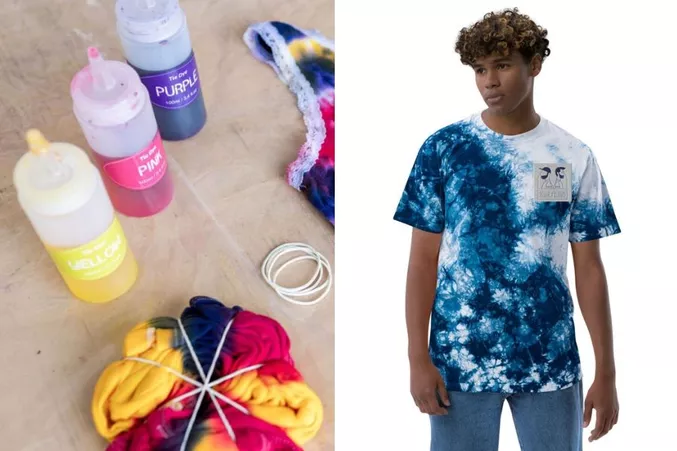Tie Dye is a popular fashion trend that offers unlimited options for self-expression. Learn how to create stylish tie dye shirts at home with Fashion Bandung.
1. Introduction to Tie Dye
Brief overview of the meaning, origins, and background of Tie Dye.
Tie Dye, also referred to as tie dyeing, is an exceptional and creative method of dyeing fabric. It involves tying, folding, or crumpling the fabric before dyeing to create distinctive streaks, stripes, or geometric patterns. This technique sets it apart from traditional dyeing methods. The beauty of tie dye lies in its spontaneous and unpredictable nature, resulting in one-of-a-kind products with vibrant colors and unique patterns. Each tie-dyed item showcases the wearer’s creativity and personality, making it a popular choice for those seeking a personalized and artistic touch.
-
History of Tie Dye
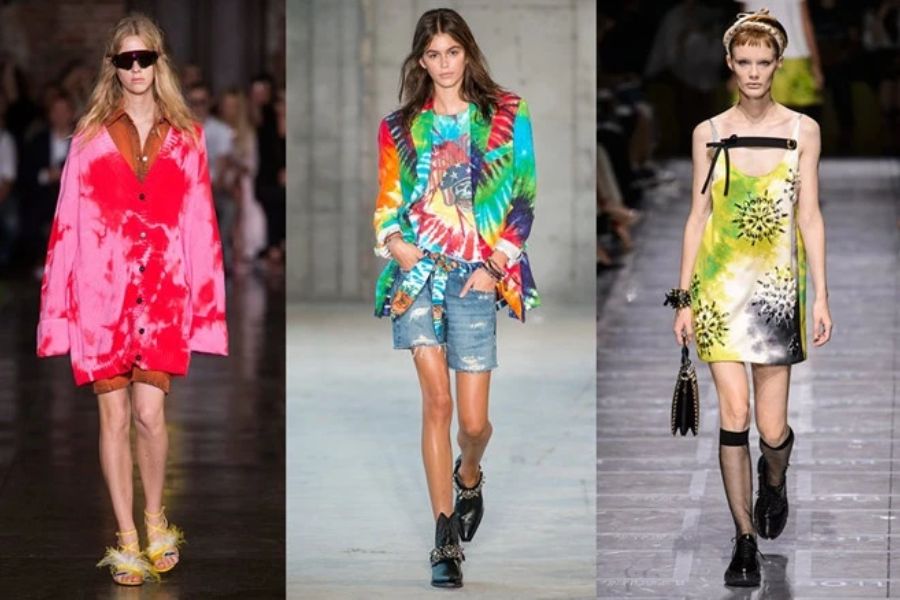
Tie-dye is a creative textile dyeing technique that involves folding, twisting, or tying fabric in different patterns and then applying various dyes to create vibrant and unique designs.
The history of Tie Dye dates back to various cultures across the globe, each possessing distinct techniques and styles. However, the most significant influences on contemporary Tie Dye can be attributed to two specific cultures.
- India: The Indian Bandhani dyeing technique, dating back to 4000 BC, uses knots and coils to create intricate patterns on fabric.
- Japan: The Japanese technique of Shibori, which emerged in the 8th century, uses folding, tying, and sewing methods to create intricate geometric designs and patterns.
1.2. Current Trends of Tie Dye
Modern fashion incorporates tie-dye in various applications, showcasing the technique in clothing, accessories, and even footwear.
Tie Dye has evolved beyond its traditional association with simple T-shirts. In today’s modern fashion scene, it is extensively utilized with a wide range of innovative designs and styles.
- Skin: T-shirts, shirts, jeans, skirts, dresses,… are dyed with Tie Dye in a variety of colors and patterns.
- Accessory: Scarves, handbags, hats, caps, shoes,… are decorated with Tie Dye patterns to create unique accents.
- Premium Clothing: Several high fashion designers have brought Tie Dye to the catwalk, turning it into a chic and classy trend.
- Sports clothes: Tie Dye brings dynamism and personality to sportswear, helping the wearer express their own style when exercising or participating in sports activities.
Prominent tie-dye trends in today’s fashion industry.
- Tie Dye pastel: Use soft, bright colors to create a sweet and feminine feeling.
- Tie Dye neon: Use bright, eye-catching neon colors to show personality and stand out.
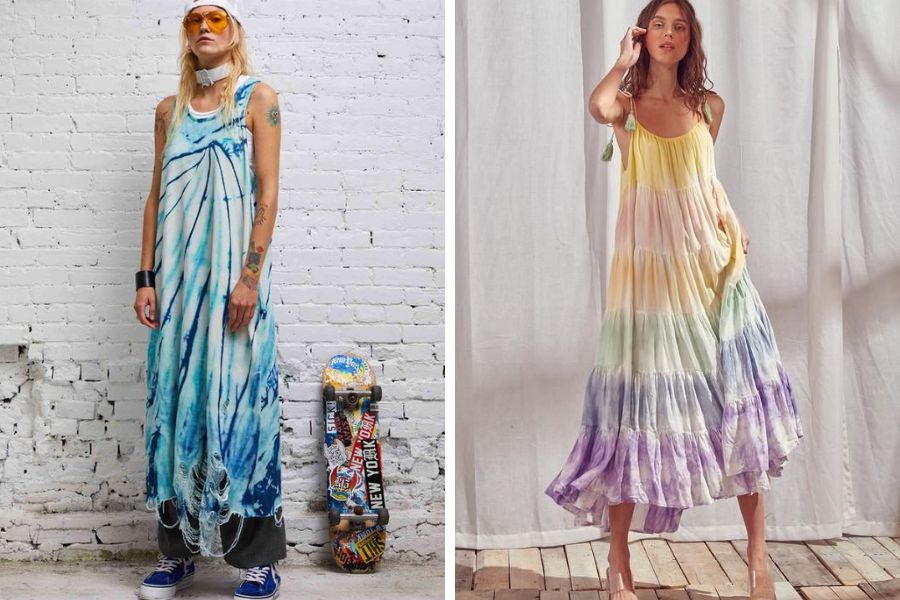
Here are some notable Tie Dye trends that are currently popular in modern fashion.
- Tie Dye dip-dye: Gradient dyeing from light to dark or vice versa creates a unique color transition effect.
- Tie Dye Ombre: Dyeing blends multiple adjacent colors to create a subtle and soft color transition effect.
- Tie Dye bleach: Use bleach to create patterns on Tie Dye fabric, bringing a unique and unconventional style.
Different tie-dye techniques can be used to create unique patterns at home.
Gather necessary tools and materials in advance.
To embark on your own Tie Dye creation journey, gather the following tools and materials:
1. Fabrics: Select white or light-colored fabrics such as t-shirts, dresses, bandanas, or pillowcases. Natural fabrics like cotton or linen work best, as they absorb dye more effectively.
2. Dye: Opt for high-quality, color-fast dyes specifically designed for Tie Dye projects. These can be purchased in powdered or liquid form from craft stores or online. Choose a variety of colors to unleash your creativity.
3. Water: Ensure access to clean water for diluting the dyes and rinsing the fabrics after dyeing.
4. Protective Gear: Wear gloves to protect your hands from staining. Additionally, consider wearing an apron or old clothes that you do not mind getting dye on.
5. Mixing Utensils: Use plastic containers or squeeze bottles to mix the dye. Avoid using utensils made of metal, as they can react with the dye and affect the final result.
6. Rubber Bands: These are essential for creating various tie-dye patterns. Gather an assortment of rubber bands in different sizes for different effects.
7. Surface Protection: Cover your work area with a plastic tablecloth or old newspapers to prevent staining.
8. Plastic Bags or Plastic Wrap: After dyeing, these will be used to wrap and let the colors set into the fabric. Make sure you have an ample supply.
9. Design Inspiration: Collect designs or patterns that you would like to recreate on your fabrics. You can find inspiration from online tutorials, books, or even create your own unique patterns.
10. Patience and Creativity: Lastly, bring your enthusiasm and artistic flair to the process. Tie Dyeing is a fun and experimental art form, so be open to trying new techniques and let your imagination run wild.
By gathering these tools and materials, you will have everything you need to dive into the vibrant world of Tie Dye and create your own dazzling masterpieces.
Fabric is a material made up of woven fibers that can be used for various purposes such as clothing, upholstery, and drapery. It can be made from natural fibers such as cotton, silk, and wool, or synthetic fibers like polyester and nylon. Fabrics can have different textures, colors, and patterns, making them versatile for different applications.
- White (or light colored) T-shirt: 100% cotton is the best choice for a nice, clear dye. You can also use other fabrics like spandex, linen, etc.
- Towels, socks, or any other fabric you want to dye.
Dye is a substance that is used to add color to something. It can come in various forms such as liquids, powders, or pastes. Dyes are commonly used in industries such as textiles, cosmetics, and printing to enhance the appearance of products. They are typically applied to materials such as fabric, paper, or hair, and can be permanent or temporary depending on the type of dye used. Dyes can be made from natural sources like plants or animals, or they can be synthetically produced through chemical processes. They are often selected based on their colorfastness, which refers to how well the dye resists fading or running when exposed to factors like light, water, or washing. Dyes play a significant role in adding vibrancy and visual appeal to a wide range of products in our everyday lives.
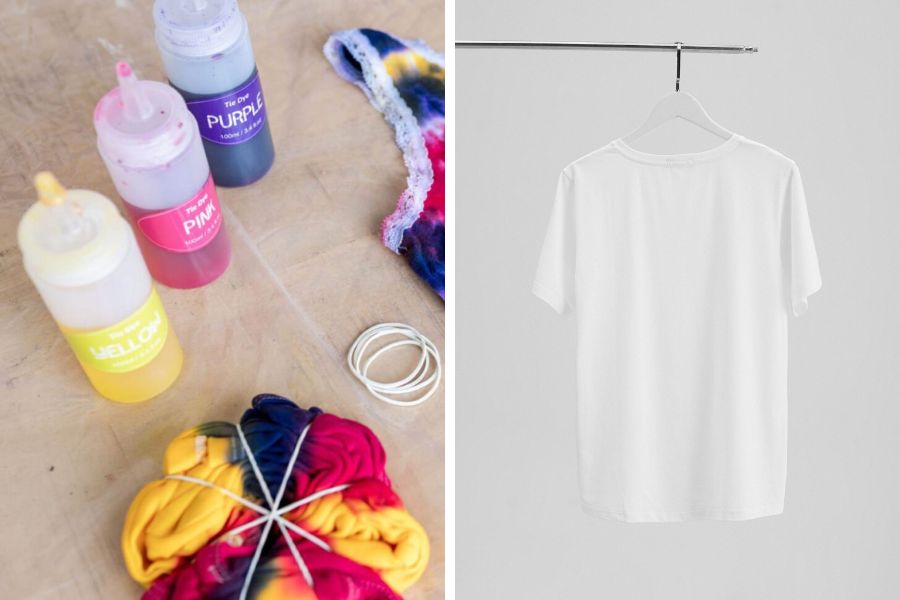
The first step is to gather all the necessary tools and materials that are required for the task at hand. This may include items such as a hammer, screwdriver, measuring tape, paintbrushes, safety goggles, and gloves. It is important to ensure that you have everything you need before starting any project to avoid any disruptions or delays. Take the time to double-check your list and gather any missing items to ensure that you are fully prepared to tackle the task with confidence.
- Tie Dye: Tie dye comes in a variety of colors and effects. You can find it at craft stores or order it online.
- Regular dye: If you can’t find Tie Dye, you can use regular fabric dye. However, the color effect may not be as beautiful and clear as using specialized Tie Dye.
Tool:
The tool that is being referred to is a device or instrument that is used to perform a specific task, achieve a particular goal, or solve a particular problem. It can be an object that is held in the hand and manipulated manually, such as a hammer or a screwdriver. Alternatively, it can be a piece of software or computer program that is used to perform digital tasks or facilitate workflows, such as a spreadsheet or graphic design software. The term “tool” can also be used metaphorically to describe a person or thing that is useful or helpful in achieving a desired outcome.
- Elastic band (large): Used to tie or fold fabric into desired shapes.
- Rubber gloves: Protect hands from dye.
- Water: Dilute the dye and rinse the fabric after dyeing.
- Plastic bag: Keeps fabric moist while dyeing.
- Work surface: Protects your work surface from dye.
- Newspaper or old towels: Place under the table to avoid dirtying the floor.
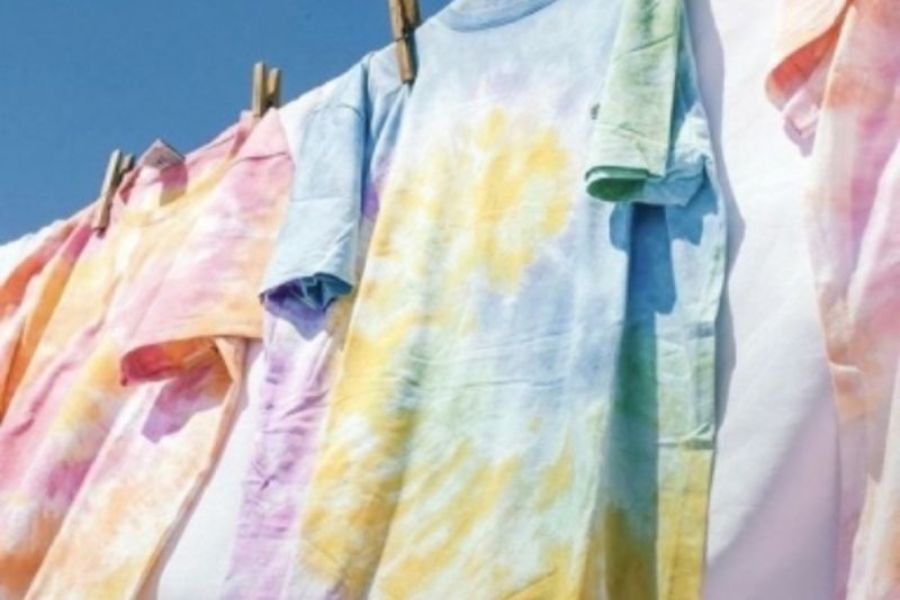
Tie dye tools are equipment or supplies specifically used for tie dyeing. These tools can include items such as dye bottles or squeeze bottles for applying the dye, rubber bands or string for creating patterns or securing fabric, plastic gloves to protect the hands from dye, and measuring tools for precise dye mixing. Additionally, other tools like buckets or containers for soaking fabric, plastic or tarp for covering work areas, and clothespins or clips for hanging or securing dyed fabric may also be considered tie dye tools. These tools are essential for achieving desired tie dye patterns and ensuring a successful and enjoyable tie dyeing experience.
Other tools that can be used are supplementary and not required.
- Spray: Helps create more detailed patterns.
- Pencil and ruler: Draw desired shapes onto fabric before tying.
- Plastic clips: Hold fabric folds tightly.
- Disposable plastic gloves.
2.2. Basic tie dye techniques:
Tie dye is a form of artistic expression that allows for limitless creative possibilities. It involves using various dyeing techniques to create unique patterns and designs. If you’re interested in trying tie dye at home, here are a few basic techniques to get you started.
1. The first step is to crumple the object. Take the item and gently squeeze or press it in your hands, causing it to bend and fold.
- Simple and easy technique to create an artistic random color bleeding effect.
-
Doing:
- Crumple the t-shirt into a ball or shape of your choice.
- Secure with elastic band to keep form.
- Dip or apply dye to the garment.
2. Spiral:
A spiral is a geometric shape that starts from a central point and gradually expands outward in a continuous curve. It rotates around the central point, creating a pattern that resembles a coiled spring or a winding staircase. The curve of a spiral can vary in tightness or looseness, depending on its dimensions. It is a visually appealing shape that can be found in the natural world, such as in seashells, galaxies, and whirlpools. The spiral shape is also utilized in various man-made objects, including spiral staircases, springs, and DNA strands. Its symmetrical and repetitive nature makes it an intriguing design element in art, architecture, and mathematics.
- Create unique and eye-catching spiral patterns.
-
Doing:
- Fold the t-shirt into a spiral, starting at the center and working outward.
- Secure with elastic band.
- Dip or apply the dye to the shirt in a spiral motion.
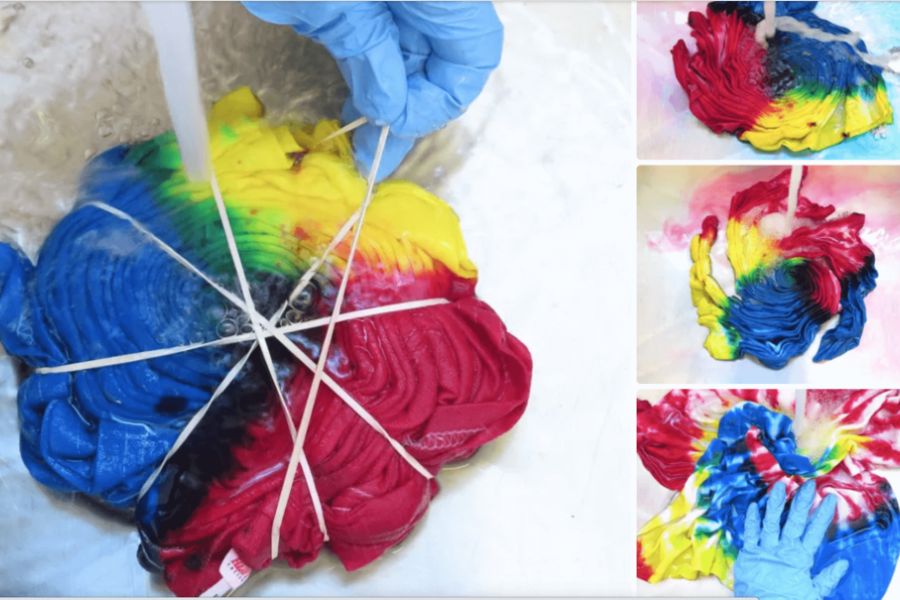
There are several popular tie dye techniques that people enjoy using. These techniques involve using different methods to create unique and colorful patterns on fabric. Some of the most common techniques include spiral, crumple, bullseye, and accordion folds. Each technique produces a distinct result, allowing individuals to express their creativity and personal style through tie dye. People often use these techniques to transform plain garments or fabrics into vibrant, eye-catching works of art.
Shibori is a traditional Japanese textile dyeing technique. It involves folding, twisting, or tying fabric before dyeing it to create unique patterns and designs. Shibori can be done using various methods like stitching, binding, or clamping the fabric to create resistance and prevent certain areas from absorbing the dye. It is a meticulous and time-consuming process that requires skill and precision. Shibori is often used to create beautiful and intricate designs on garments, home furnishings, and other textile items.
- Traditional Japanese techniques use folding, tying, and sewing methods to create intricate geometric or floral patterns.
-
There are many different styles of Shibori with their own names and ways of performing them, such as:
- Kimekomi: Fold and sew fabric into desired shapes before dyeing.
- Arashi Shibori: Tie the fabric into small bundles and dye in different directions.
- Itajime Shibori: Clamp the fabric between two flat wooden boards before dyeing.
Color Dipping refers to the process of immersing an object or material into a coloring solution or pigment to change its color. This technique involves submerging the item into a container filled with the desired coloring agent, allowing the material to absorb the color and enhance its appearance. Color dipping can be used for various purposes, such as giving a fresh look to old or worn-out items, creating unique and vibrant decorative pieces, or achieving uniform colorization in industries like textiles or manufacturing.
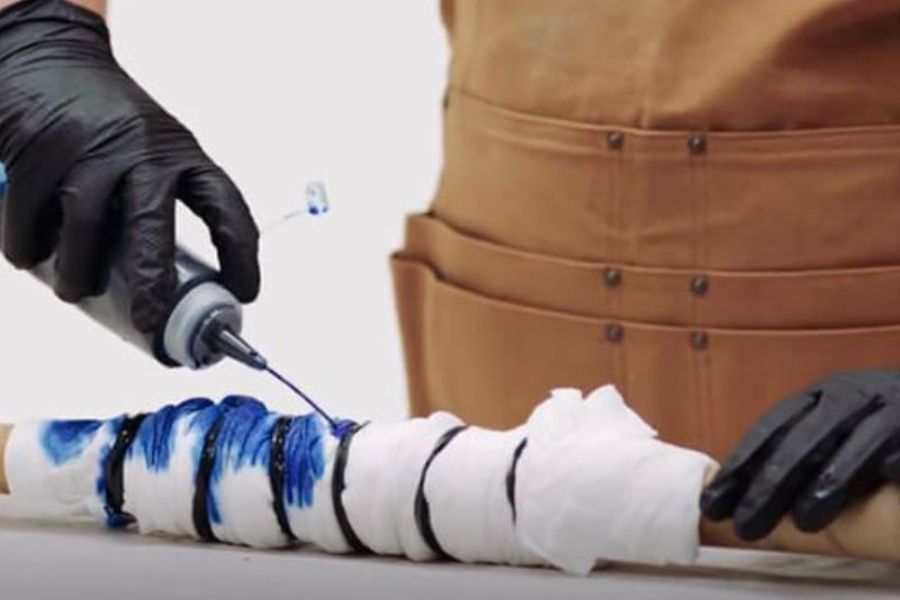
The most fundamental tie dye techniques involve creating patterns and designs on fabric using various dyeing methods.
- Create simple yet impressive stripes or large blocks of color.
-
Doing:
- Dip a section of the t-shirt directly into the dye solution.
- Different colors can be used to create an ombre effect.
- Secure the undyed part of the shirt with elastic to create a clear outline.
2.3. Steps for Implementation:
-
Prepare:
- Wash and dry the t-shirt.
- Spread out the table, place newspaper or old towels on top.
- Wear rubber gloves.
- Tie the t-shirt using the chosen technique.
-
Dye mixing:
- Mix the dye according to the instructions on the package.
- Multiple colors can be blended to create unique effects.
-
Dyeing shirt:
- Dip or drop dye onto shirt as desired.
- Spray bottles can be used to create more detailed designs.
-
Incubate clothes:
- Place the shirt in a plastic bag and cover for at least 30 minutes or overnight.
-
Washing and drying clothes:
- Rinse shirt under cold water until water runs clear.
- Wash shirt with mild soap.
- Dry the shirt in the sun or in the dryer.
Tips for tie-dyeing shirts: take notes while dyeing to track colors used and techniques applied.
3.1 Choose the right fabric
Choosing the right fabric is crucial in achieving a visually appealing and long-lasting Tie Dye effect. Consider the following factors when selecting your fabric:
1. Type of fabric: Different fabrics yield different results when tie-dyed. Some common options include cotton, rayon, silk, and linen. Cotton is a popular choice due to its ability to absorb dyes well and retain colors over time. Rayon and silk can result in vibrant and smooth colors, while linen may give a more textured look.
2. Weight and thickness: The weight and thickness of the fabric can impact the final outcome. Lighter fabrics, such as lightweight cotton or rayon, are easier to work with and tend to absorb dyes more evenly. Thicker fabrics, like heavy cotton or denim, may require more dye and longer processing times to achieve desired results.
3. Texture and weave: Consider the texture and weave of the fabric, as it can affect how the dye is absorbed and distributed. Smooth, tightly woven fabrics are ideal for achieving detailed and precise patterns, while looser weaves or textured fabrics may give a more organic and random tie-dye look.
4. Pre-treatment requirements: Some fabrics may require pre-treatment before dyeing to ensure optimal color absorption. For example, cotton fabrics might benefit from pre-washing to remove any sizing or chemicals that could hinder dye penetration.
5. Colorfastness: Check the fabric’s colorfastness, which is its ability to retain color over time and through washes. Look for fabrics labeled as “colorfast” or “dye-ready” to ensure that the tie-dye effect remains vibrant and does not fade quickly.
By considering these factors, you can select the most appropriate fabric for your tie-dye project, ensuring both aesthetic appeal and durability.
Choosing a fabric that is made from 100% cotton is highly recommended for various reasons. Cotton fabric is known for its exceptional qualities, making it an ideal choice for a wide range of applications. When it comes to comfort, cotton fabric excels as it is soft and breathable, allowing air to circulate freely and keeping the wearer cool and comfortable.
In addition to its comfort, cotton fabric is also highly durable. It is resistant to wear and tear, making it suitable for everyday use and ensuring that it will last for a long time. Moreover, cotton fabric is easy to care for, as it can be machine-washed and dried without losing its shape or color.
Cotton fabric is also a natural and sustainable choice. It is derived from the cotton plant and requires minimal processing, making it an environmentally friendly option. Additionally, cotton fabric is hypoallergenic and does not irritate the skin, making it suitable for individuals with sensitive skin or allergies.
Whether you are looking for clothes, bedding, or any other textile product, opting for 100% cotton fabric ensures quality, comfort, durability, sustainability, and hypoallergenic properties. With all these benefits, it is no wonder that 100% cotton fabric is considered the best choice in the market.
- Cotton has good absorbency, helping dyes easily penetrate each fabric fiber, creating clear and long-lasting colors.
- Cotton fabric is also soft and airy, suitable for wearing in many weather conditions.
Here is a list of additional fabrics that can be successfully dyed:
– Cotton: A versatile and popular fabric that is easy to dye and holds color vibrantly. It is breathable and soft, making it comfortable to wear.
– Linen: Another natural fiber that dyes well. Linen has a distinctive texture and is known for its durability and ability to keep cool in hot weather.
– Silk: A luxurious and delicate fabric that takes dye beautifully. Silk has a smooth and lustrous appearance, making it ideal for dyeing vibrant and rich colors.
– Wool: A warm and cozy fabric that often comes in various textures, such as merino or cashmere. Wool readily absorbs dyes, creating deep and rich hues.
– Rayon: A semi-synthetic fabric that mimics the feel and appearance of silk. Rayon is known for its versatility in absorbing dyes, resulting in bright and bold colors.
– Nylon: A synthetic fabric that is commonly used in activewear and swimwear. Although nylon is less receptive to dye compared to natural fibers, it can still be successfully dyed with the right techniques and dyes.
– Polyester: Another popular synthetic fabric with high resilience and wrinkle resistance. Polyester can be dyed using special dyes designed for synthetic materials, giving it a permanent and fade-resistant color.
– Blends: Fabrics made from a combination of fibers, such as cotton-polyester or wool-silk blends, can also be dyed. However, the dyeing process may result in different color absorption rates for each fiber, creating unique and interesting color effects.
- Cotton, linen, rayon, etc. can also be Tie Dye dyed, however the color effect may not be as beautiful and clear as on cotton fabrics.
- It is a good idea to test dye a small piece of fabric first to see how the colour turns out.
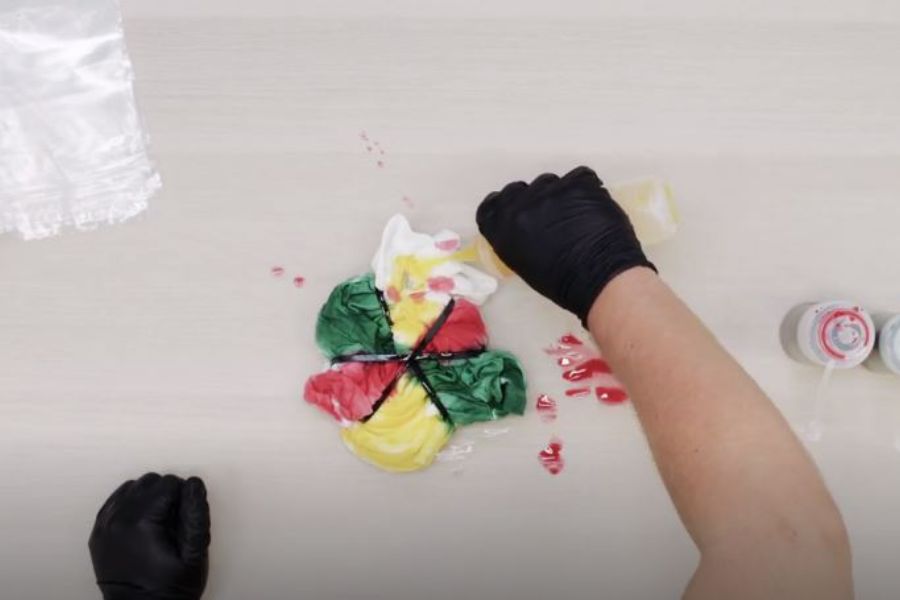
Here are some important points to keep in mind when dyeing tie dye shirts:
1. Fabric choice: Select shirts made of 100% cotton for best results. The dye adheres better to natural fibers like cotton and produces vibrant colors.
2. Pre-wash the shirts: Before dyeing, it is recommended to pre-wash the shirts to remove any dirt, stains, or sizing chemicals that may affect the dye’s absorption.
3. Prepare the dye: Follow the instructions provided with your tie dye kit to prepare the dye mixture. Different dyes may require different preparations, such as mixing with water or salt.
4. Set up a work area: Prepare a well-ventilated area with a plastic sheet or newspapers to protect your work surface from any spillage or splattering. It is also advisable to wear gloves and an apron to protect your hands and clothes.
5. Design your shirt: Use rubber bands, strings, or other tying materials to create patterns on the shirt. Experiment with different techniques like spirals, crumpling, or folding to achieve varied designs.
6. Apply the dye: Squeeze or pour the dye onto the shirt, following the desired pattern. Remember to work from light to dark colors and leave some white space between different colors to prevent them from blending together.
7. Let the dye set: Once you have applied the dye, carefully wrap the shirt in plastic wrap or place it in a ziplock bag to keep it moist. Allow the dye to set for at least six to eight hours or as recommended by the dye manufacturer.
8. Rinse the shirt: After the dye has set, rinse the shirt under cold water until the water runs clear. This will remove excess dye and help set the colors.
9. Wash and dry the shirt: Finally, wash the shirt separately in cold water with a mild detergent to further remove any remaining dye. After washing, air dry or tumble dry the shirt following the manufacturer’s instructions.
By following these guidelines, you can create beautifully vibrant and unique tie dye shirts. Remember to have fun and let your creativity shine while experimenting with different colors and designs!
Please take note of the following important information.
- Avoid using synthetic fabrics like polyester, nylon, etc. as these fabrics do not take dyes well and the color may be uneven.
- Newly washed and untreated fabric will give a better color effect than fabric that has been used many times.
Wash and protect your Tie Dye shirts to maintain their vibrant colors and patterns.
Instructions for washing your hair for the first time after dyeing:
- Wash Tie Dye shirts separately in cold water and mild soap.
- Do not use bleach or hot water as this may cause the dye to fade.
- Gently wring out the shirt by hand or use the gentle cycle of your washing machine.
- Dry the shirt in the shade or mild sunlight.
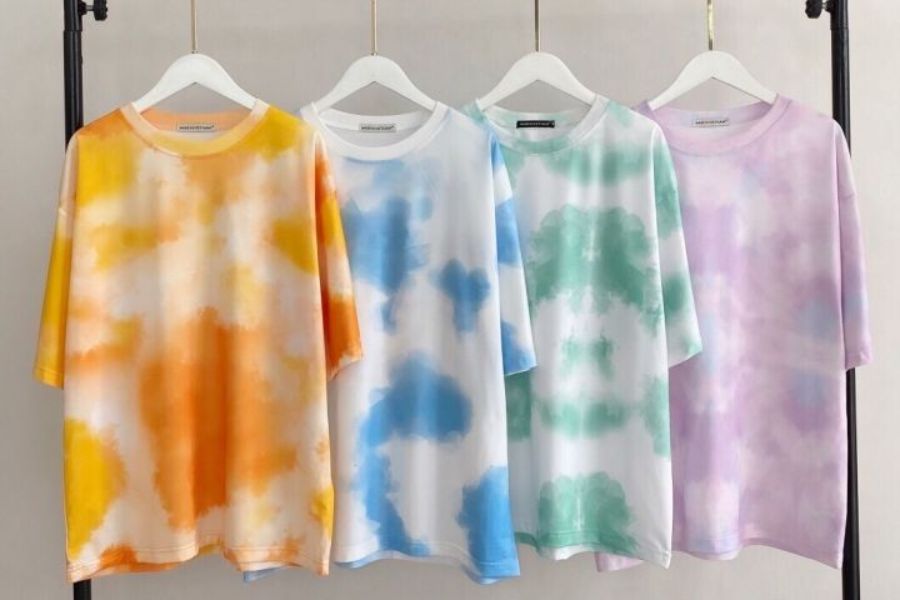
Instructions for washing and preserving tie dye shirts:
To properly care for your tie dye shirts and ensure their longevity, follow the steps below:
1. Separation: Before washing your tie dye shirt, separate it from other garments to prevent color bleeding and fading.
2. Pre-treatment: Treat any stains on the shirt before washing. Apply a stain remover directly to the affected areas and gently rub the fabric together to work the solution in. Let it sit for a few minutes before proceeding to the next step.
3. Hand washing: Fill a basin or sink with lukewarm water. Add a mild detergent specifically designed for delicate fabrics. Avoid using bleach or harsh chemicals that may fade or alter the colors of the tie dye. Submerge the shirt in the soapy water and gently agitate it for a few minutes, paying attention to any stained areas. Rinse thoroughly with clean water until no soap residue remains.
4. Machine washing (optional): If hand washing is not possible or convenient, you can also machine wash your tie dye shirt. However, it is essential to use the gentle cycle and cold water to prevent the colors from running or bleeding. Again, avoid using bleach or abrasive detergents.
5. Drying: After washing, gently squeeze out excess water from the shirt. It is crucial not to wring or twist the fabric, as this may distort the tie dye pattern. Lay the shirt flat on a clean towel and roll it up, pressing gently to absorb more water. Unroll the towel and reshape the shirt if necessary. Finally, lay it flat or hang it until it is completely dry. Avoid direct sunlight, as it can fade the colors over time.
6. Ironing: If needed, iron your tie dye shirt on the reverse side using a low heat setting. Place a cloth or thin fabric between the iron and the shirt to prevent direct contact that may damage the dye pattern.
By following these detailed instructions, you can ensure that your tie dye shirts remain vibrant and beautiful for a long time.
Important preservation steps to maintain the lasting color of dyes:
1. Select high-quality dyes: Choose dyes that are known for their longevity and color-fastness. This ensures that the dye will hold its color for an extended period.
2. Proper washing technique: When washing dyed fabrics, use cold water and a gentle detergent specifically designed for colored clothing. Avoid using harsh detergents or bleach, as they can fade the color of the dye.
3. Separate colored items: Wash colored items separately from white or light-colored clothing to prevent color bleeding. This can be especially important during the initial washes when the dye may still be prone to bleeding.
4. Use fabric softeners sparingly: Fabric softeners can impact the color retention of dyes, so it is advisable to use them sparingly or avoid them altogether when washing dyed fabrics.
5. Wash inside out: Turning the dyed item inside out before washing can help protect the color from rubbing against other clothing items or the drum of the washing machine, which can lead to fading.
6. Avoid excessive heat: High temperatures can cause dyes to fade, so it is recommended to avoid using high heat when drying dyed items. Instead, opt for low or medium heat settings or air drying.
7. Store away from sunlight: Sunlight can bleach and fade dyes over time. To preserve the color, store dyed items in a cool and dark place or use hangers and garment bags that offer protection from direct sunlight.
8. Test colorfastness before spot cleaning: If a dyed item needs spot cleaning, test an inconspicuous area first to ensure that the dye color does not bleed or fade during the cleaning process.
9. Handle with care: Avoid excessive rubbing or exposure to abrasive surfaces, as this can cause the dye to wear off or fade. Treat dyed items gently during both washing and wearing.
10. Follow care instructions: Always refer to the care instructions provided by the manufacturer for specific guidance on how to best preserve the color of dyed items. This may include recommended washing temperatures, drying methods, or special instructions for delicate dyes.
- Wash Tie Dye after each wear or when soiled.
- Avoid drying clothes in direct sunlight for long periods of time.
- Wash shirt by hand or use gentle cycle of washing machine.
- Do not use bleach or hot water.
- Store Tie Dye shirts in a cool, dry place.
Conclude
The fashion trend of Tie Dye has gained significant popularity and continues to remain strong, capturing the attention of people worldwide. It offers an undeniable appeal to individuals seeking to express their personal style and showcase their unique personality. With its wide range of vibrant colors, intricate patterns, and versatile application techniques, Tie Dye provides endless possibilities for fashion enthusiasts to explore and experiment with. It empowers wearers to make a bold statement and showcase their individuality through their clothing choices.

Editor: To Thi Bich Tram
Job: Editing and proofreading
Skills: Proficient in English language and grammar, attention to detail, experience in editing and proofreading documents
Responsibilities: Reviewing and editing documents for grammar, punctuation, spelling, and clarity, ensuring adherence to style guidelines, providing feedback and suggestions for improvement, checking for consistency and coherence in content, conducting fact-checking when necessary, meeting deadlines, collaborating with authors and other team members to ensure high-quality work
Background: Well-versed in English grammar and writing conventions, experienced in editing a wide range of documents including academic papers, business reports, and creative writing pieces, knowledgeable in using editing software and tools, excellent communication and interpersonal skills, ability to work independently and stay organized, committed to delivering polished and error-free work to enhance the readability and effectiveness of written materials.

